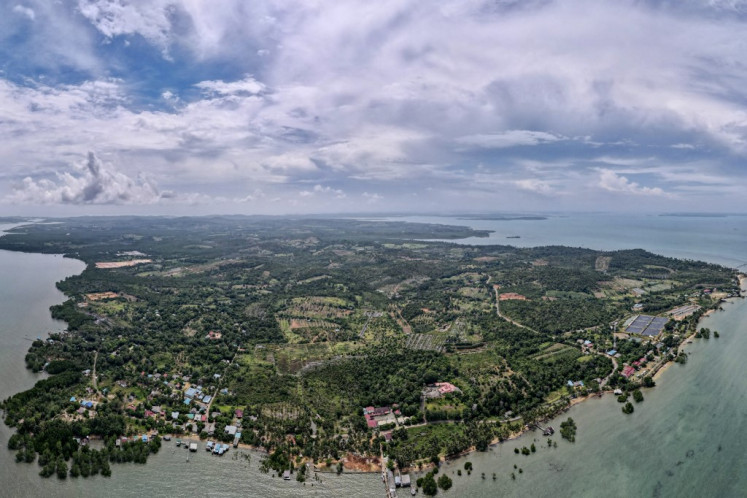Popular Reads
Top Results
Can't find what you're looking for?
View all search resultsPopular Reads
Top Results
Can't find what you're looking for?
View all search resultsChallenges in e-government implementation
With over 250 million people, Indonesia has the worldâs fourth-largest population and the largest in Southeast Asia
Change text size
Gift Premium Articles
to Anyone
W
ith over 250 million people, Indonesia has the world's fourth-largest population and the largest in Southeast Asia. While the government's vision for information and communications technology (ICT) is 'to bring into reality a modern information society, prosperous and highly competitive, with strong support from ICT', the current development is still a long way off this goal.
The country does not yet have a complete database with the total number of local governments that have implemented online services.
The UN defines e-government as 'utilizing the Internet and the world wide web for delivering government information and services to citizens'. According to a report in 2000 for the National Electronic Commerce Coordinating Council, government agencies can save up to 70 percent by moving services online, thus becoming more economically efficient.
Moreover, the social benefits of adopting e-government systems include improved public services, increased citizen empowerment as a result of better access to information and increased accountability and transparency, which could then mitigate corruption, as cited by the World Bank.
The development of e-government could also be viewed as a change in the way the government interacts with communities, businesses and its citizens.
While the Indonesian government recognizes the benefits of e-government, and has initiated various policies since 2003 to support its implementation (i.e. development of reliable systems and infrastructure, quality and service guidelines and standards, as well as the regulation of public service transactions), these policies have yet to yield substantive results in e-government services in the country.
Last year's UN survey on e-government found developing countries could be divided into two groups. The first comprises those countries advancing e-government services despite relatively low national income. These include Bolivia, Ghana, Honduras, India, the Philippines, Vietnam and Uzbekistan.
The second group is those countries that have not reached the level of e-government development that other countries in the same income group have.
Indonesia falls into this group, together with others such as Cape Verde, Guatemala, Guyana, Micronesia, etc. Thus, there is a huge potential for the development of e-government services in Indonesia.
In a vast country like Indonesia, the lack of resources and skills is not only ICT-related, but also affects basic infrastructure and public services ' a challenge to effective e-government.
Although many local businesses have computerized their operations, the present ICT infrastructure in Indonesia serves less than 5 percent of the population, thus more could be done to exploit the capabilities of ICT for pro-poor development.
Furthermore, with the persisting urban-rural divide in most low-income countries, less developed regions, which could benefit the most from the adoption of ICT, are often the last to receive such services.
The reach of ICT in Indonesia is also limited to a very small privileged group; there are only 8.7 Internet users per 100 people and 8.3 people per 100 have personal computers.
However, a substantial number of people, 69.2 per 100, have cell phones. Accessing the Internet from their phones would enable these individuals to search for government information online and participate in public policy plans, programs and public decision-making processes.
Our qualitative study has identified several main bottlenecks in e-government in Indonesia.
Some local government websites have serious problems in their User Experience Design (UED). Thisconcerns the supply and demand of data ' what data is needed and what information is available on a website.
Further, there is no contact information on most government websites. Users seeking further information may thus need to start from scratch by searching for and contacting the relevant officer by email or phone. There is also no standard response time for which users might expect the queries to be attended to.
The other problem concerns incomplete databases; the availability of long-term data and the commitment to make regular updates on a database are often ignored. As there is no clear-cut information on why some data was not available, besides the more current releases, some might speculate that the incompleteness of the data might be presented on purpose; thus the only way to obtain the missing public data would be to purchase it from relevant government agencies.
Human resources also play a crucial role. Some activities such as web design and development are procured based on government tenders, and thus outsourced.
These contractors work for a temporary period depending on when the budget for the next year is released, thus limiting the sustainability of data information and presentation. Internally, there are limited skilled human resources to manage it.
On a positive note, there has been some success on the e-government front denoted by certain initiatives. For instance, Lapor (report) is an anticorruption tool that allows citizens to report on the malpractices of Indonesia's government, which can be done through a website, mobile app or SMS. The team behind Lapor is the Presidential Working Unit for the Supervision and Management of Development (UKP4), initiated under the previous administration.
Hence, there is promise of some advancement in e-government in Indonesia. Perhaps, by first addressing more critical problems such as stamping out corruption within the system, Indonesia can work its way toward a more stable and efficient e-government system that can be used for pro-poor development.
What is needed next is the enforcement of the regulations. For instance, public information dissemination based on Law No. 14/2008 has given liability to any public agencies (central and local) for providing open access to public information.
The law aims to guarantee citizens the right to information about the planning of public policy programs, and public decision-making processes.
Law No. 25/2009 on public services overreaches the importance of a public database setting clear boundaries and relationships about the rights, responsibilities and authority of all parties associated with public service delivery.
Disseminating these regulations to all stakeholders will serve as a tool to stimulate the emergence of e-government to ultimately achieve a modern information society that is prosperous and highly competitive, with strong support from ICT.
_______________________
The present ICT infrastructure in Indonesia serves less than 5 percent of the population.
________________________
Sri Ranjini Mei Hua, who obtained her Master's in sociology at the London School of Economics and Political Science, is a consultant at Cognitive Edge living in Singapore. Ibrahim Kholilul Rohman, who obtained his PhD in technology management and economics at Chalmers University of Technology in Gothenburg, Sweden, is an ICT industry analyst in Seville, Spain.










